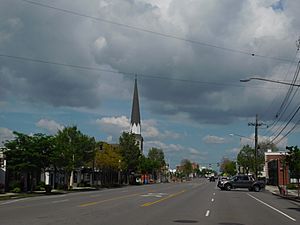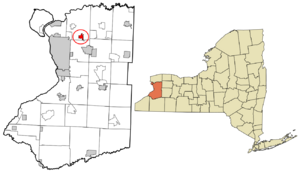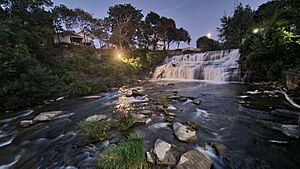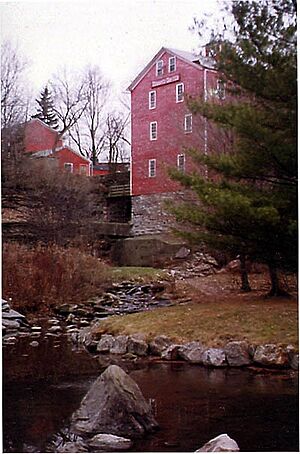Williamsville, New York facts for kids
Quick facts for kids
Williamsville
|
|
|---|---|
| Village of Williamsville | |

Downtown Williamsville along NY 5
|
|

Location in Erie County and New York
|
|
| Country | United States |
| State | New York |
| County | Erie |
| Towns | Amherst |
| Named for | Jonas Williams |
| Area | |
| • Total | 1.27 sq mi (3.28 km2) |
| • Land | 1.26 sq mi (3.26 km2) |
| • Water | 0.01 sq mi (0.02 km2) |
| Elevation | 676 ft (206 m) |
| Population
(2020)
|
|
| • Total | 5,423 |
| • Density | 4,310.81/sq mi (1,664.45/km2) |
| Time zone | UTC-5 (Eastern (EST)) |
| • Summer (DST) | UTC-4 (EDT) |
| ZIP codes |
14221, 14231
|
| Area code(s) | 716 |
| FIPS code | 36-82084 |
| GNIS feature ID | 0971319 |
Williamsville is a small village in Erie County, New York, in the United States. About 5,423 people lived here in 2020. The village is named after Jonas Williams, one of its first settlers. It's part of the larger Buffalo-Niagara Falls metropolitan area.
Williamsville is mostly located within the town of Amherst. A small part of the village, near the New York State Thruway, is in the town of Cheektowaga. It's in the northeast part of Erie County.
The Williamsville Central School District serves students from Williamsville. It also covers most of eastern Amherst and a small part of Clarence.
| Top - 0-9 A B C D E F G H I J K L M N O P Q R S T U V W X Y Z |
History of Williamsville
The community of Williamsville grew up where a main road crossed Ellicott Creek. This road connected Batavia and Buffalo. The waterfall, called Glen Falls, provided power for mills.
Early Mills and Growth
Jonas Williams built the first mill in 1811. This mill gave the village its first name, "Williams Mills." You can still see it today next to Glen Park. It is now known as the Williamsville Water Mill.
Many other mills were built near Glen Falls in the 1800s. In 1841, a channel was dug to move water from Ellicott Creek to the mills. This created an island, which is now called Island Park.
In 1827, Oziel Smith built a stagecoach stop, tavern, and inn. This building is still standing and is known as the Eagle House. The village officially became a village in 1850.
Important Buildings and People
Ss. Peter and Paul Church started in the early 1820s. The current church building was finished in 1836. St. John Neumann led this Catholic church from 1836 to 1840. He also started Ss. Peter and Paul School in 1836 and was one of its first teachers.
Williamsville During the War of 1812
During the War of 1812, American soldiers stayed in Williamsville. They were located between Garrison Road and Ellicott Creek. A field hospital and log barracks were used to treat soldiers and British prisoners. A small cemetery on Aero Drive holds the graves of those who died.
General Winfield Scott used the Evans House as his headquarters in 1813. His entire army of 5,000–6,000 men was stationed in Williamsville. When the British burned Buffalo in 1813, many people found safety in Williamsville.
Protecting History
In 1983, Williamsville created a Historic Preservation Code. This code helps protect important historic buildings and places in the village. It helps keep the unique character of Williamsville alive.
Old Home Days Festival
Every summer, Williamsville hosts a festival called Old Home Days in Island Park. The festival starts with a parade and lasts for four days. Thousands of people enjoy rides, food, and the community spirit. This festival remembers women from the mid-1800s who used to meet in the park for tea.
Village Government
In 2010, some people wanted to close down the village government. Voters had a special election on August 17, 2010. They voted by a large margin (5 to 1) to keep the village government.
Geography of Williamsville
Williamsville covers about 1.2 square miles (3.2 square kilometers) of land.
Waterways and Landforms
Ellicott Creek flows through the village from south to north. The Onondaga Escarpment is a ridge of land that runs through the village from east to west. Glen Falls is where Ellicott Creek drops over this escarpment.
Important Roads
Main Street is a major east-west road and is part of New York State Route 5 (NY 5). An early surveyor, Joseph Ellicott, improved this old path. It was known as the "Buffalo Road" and later "Main Street."
North Union Road, part of NY 277, is a main north-south road. Transit Road, also surveyed by Joseph Ellicott, marks the boundaries between different towns.
The New York State Thruway (Interstate 90 or I-90) goes through the southern part of the village. It connects to I-290.
Population of Williamsville
| Historical population | |||
|---|---|---|---|
| Census | Pop. | %± | |
| 1870 | 912 | — | |
| 1880 | 880 | −3.5% | |
| 1900 | 905 | — | |
| 1910 | 1,105 | 22.1% | |
| 1920 | 1,667 | 50.9% | |
| 1930 | 3,119 | 87.1% | |
| 1940 | 3,614 | 15.9% | |
| 1950 | 4,649 | 28.6% | |
| 1960 | 6,316 | 35.9% | |
| 1970 | 6,878 | 8.9% | |
| 1980 | 6,017 | −12.5% | |
| 1990 | 5,583 | −7.2% | |
| 2000 | 5,573 | −0.2% | |
| 2010 | 5,300 | −4.9% | |
| 2020 | 5,423 | 2.3% | |
| U.S. Decennial Census | |||
In 2020, there were 5,423 people living in Williamsville. The village had 2,364 households. The population density was about 4,284 people per square mile.
Most residents (86.4%) were White. Other groups included Asian (4.6%), African American (3.6%), and people of two or more races (4.7%). About 2.7% of the population was Hispanic or Latino.
The average age of people in the village was 45 years old. About 18.7% of the population was under 19. About 24.4% were 65 years or older.
Arts and Culture in Williamsville
Landmarks to See
Williamsville has several parks. Glen Park is 10 acres and offers views of Ellicott Creek and the 27-foot-high Glen Falls. Island Park has a large pavilion and hosts events like Old Home Days.
There are 34 places in Williamsville recognized as landmarks. The Williamsville Christian Church and the Williamsville Water Mill Complex are listed on the National Register of Historic Places.
Festivals and Events
The main festival is Old Home Days, as mentioned before. There is also the Taste of Williamsville event. During the summer, you can enjoy Music on Main. Local bands play on street corners during this musical festival.
Parks and Recreation
For fun and exercise, Williamsville has a rollerskating rink. There is also the 1.5-mile Lehigh Memory Trail, great for walking or biking.
Education in Williamsville
Children in Williamsville attend public schools in the Williamsville Central School District. This district covers the entire village and nearby areas.
The district has six elementary schools (grades K-4), four middle schools (grades 5-8), and three high schools (grades 9-12). Children from the village usually go to Forest Elementary, Mill Middle, and Williamsville South High School.
There are also private schools in Williamsville. These include Saints Peter and Paul (a Catholic school) and Christian Central Academy.
Notable People from Williamsville
Many interesting people have lived in Williamsville, including:
- Jacob Artist, an actor from the TV show Glee
- Justin Bailey, a player in the NHL (National Hockey League)
- Shirley Chisholm, a famous Congresswoman
- Rob Gronkowski, a former professional football player for the New England Patriots and Tampa Bay Buccaneers
- Robert Guthrie, a scientist who developed a test for a genetic condition in babies
- Wendie Malick, an American actor
- John Neumann, a Catholic priest and bishop who founded Ss. Peter and Paul Church
- Peter Salovey, the president of Yale University
- Lindsay Shookus, a producer for NBC
See also
 In Spanish: Williamsville (Nueva York) para niños
In Spanish: Williamsville (Nueva York) para niños



